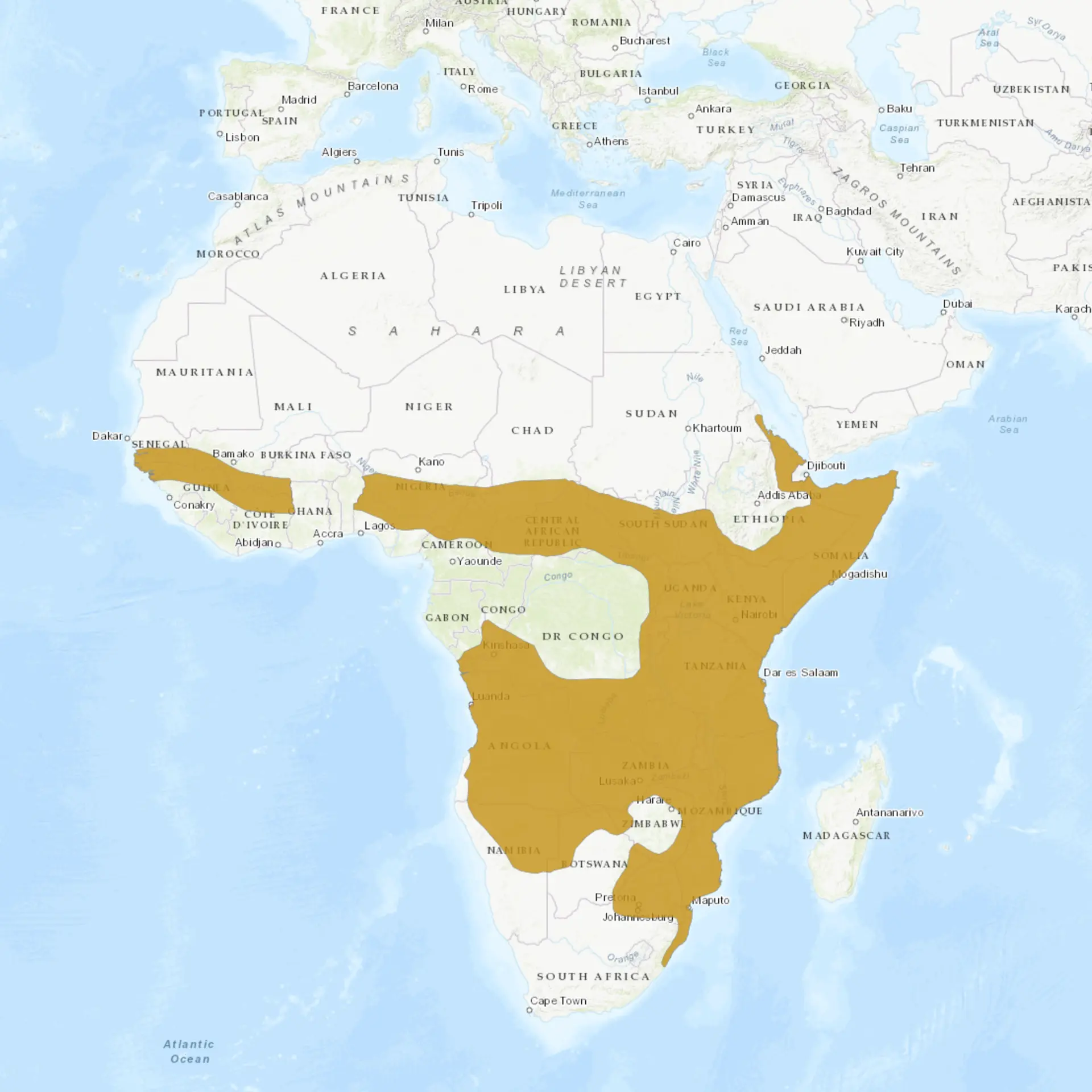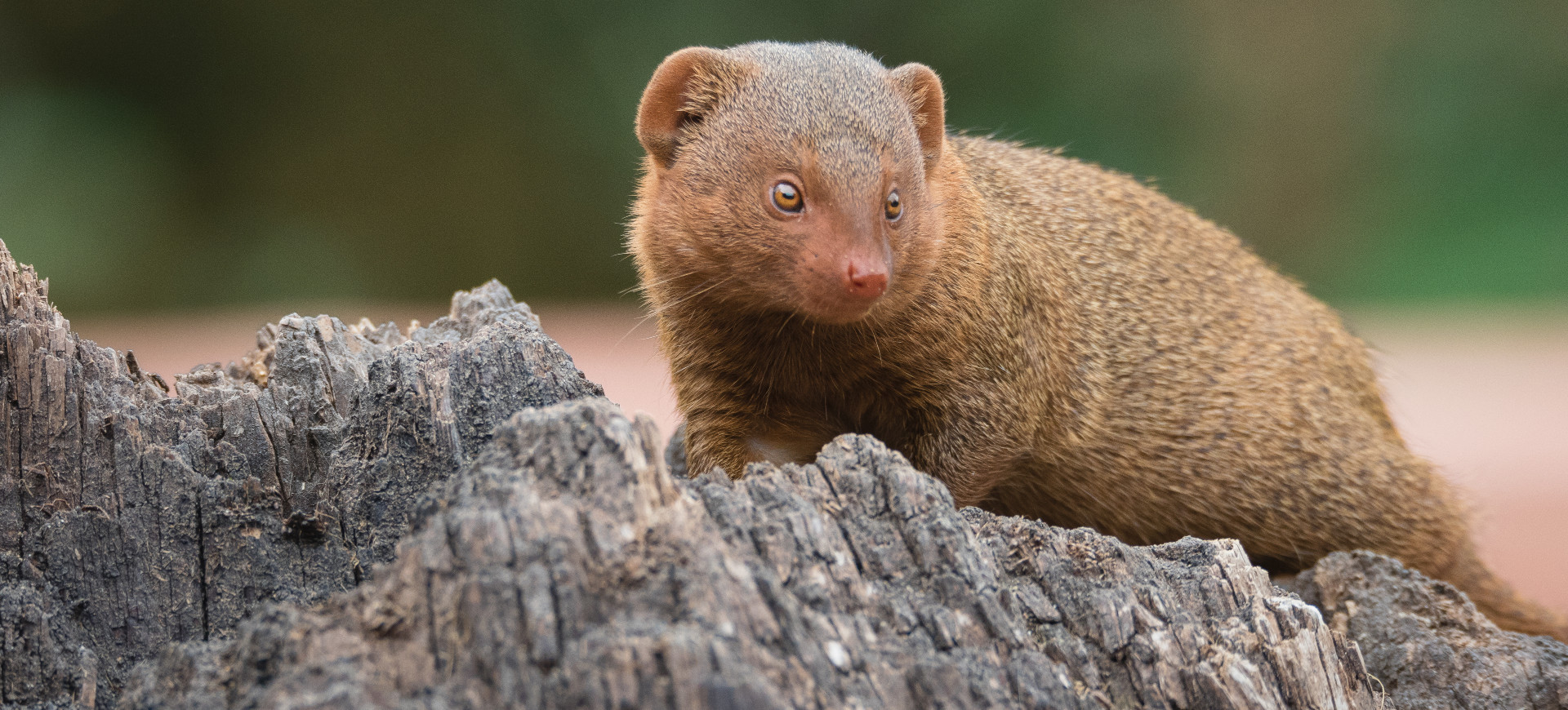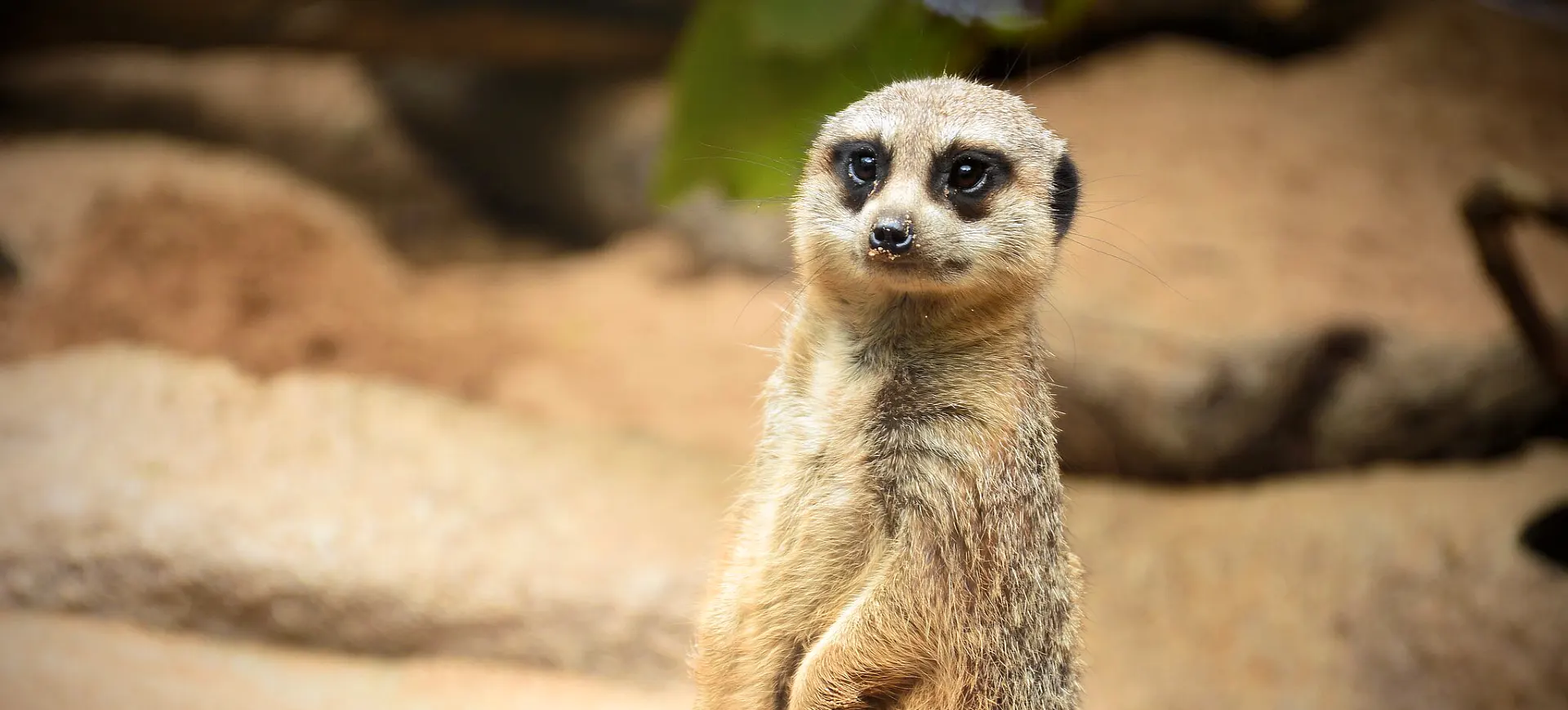Overview
The banded mongoose (Mungos mungo) is a small, highly social carnivorous mammal native to sub-Saharan Africa. It is easily recognized by the distinct dark horizontal bands running across its back and its generally grizzled brownish-gray coat. This species thrives in various habitats, including savannas, grasslands, and woodlands, and is often found near termite mounds and water sources. Known for its cooperative social structure, the banded mongoose lives in groups called troops, consisting of up to 30 individuals that work together for protection, foraging, and raising young.
These mongooses are primarily diurnal, active during the day and resting at night in communal dens. They are opportunistic feeders, consuming a diverse diet of insects, small vertebrates, eggs, fruits, and even carrion. Their sharp claws and strong teeth make them excellent diggers and efficient predators. They are often seen breaking open hard-shelled prey such as insects or eggs. Banded mongooses also display remarkable teamwork, often foraging in coordinated groups to maximize food acquisition while minimizing predator risks.
A highly adaptable species, the banded mongoose is commonly found in areas with human activity, including agricultural and rural settlements. Its resilience and ability to exploit diverse food sources have contributed to its stable population across most of its range. Despite this, it faces threats such as habitat loss and diseases, including those transmitted by contact with domestic animals. The banded mongoose plays an important role in controlling insect populations and as a prey species for larger predators in its ecosystem.
Taxonomy
Kingdom
Phylum
Class
Order
Family
Genus
Species
Type
Current distribution:
Banded mongooses are found throughout much of sub-Saharan Africa, with a range extending from Senegal and Gambia in the west to Ethiopia in the east and southward to South Africa. They are most abundant in regions with a mix of open grasslands and woodlands but can also be found in agricultural areas and near human settlements. Their distribution overlaps with other mongoose species, but they tend to avoid dense forests and arid deserts. The availability of food, water, and suitable shelter influences local populations.
Despite their stable population, some local declines have been reported due to habitat destruction and disease. Banded mongooses are susceptible to diseases like rabies and tuberculosis, particularly in areas where they interact with domestic animals. Banded mongooses remain common in regions with less human disturbance and thrive in protected reserves and national parks. Their ability to adapt to a wide range of habitats ensures that they remain widespread across much of their range.
Physical Description:
The banded mongoose is a compact and muscular mammal with an average body length of 12–16 inches (30–40 cm) and a tail measuring 6–12 inches (15–30 cm). Its coat is coarse and brownish-gray, with 10–15 dark horizontal stripes across the back, providing effective camouflage in its natural habitat. The head is relatively small and tapers to a blunt snoutd for digging and foraging. Its ears are short and rounded, while the eyes are bright and alert, reflecting its active and inquisitive nature.
The legs are short but sturdy, ending in sharp claws adapted for digging and breaking into termite mounds. Unlike other mongoose species, the banded mongoose has a bushy tail roughly the same length as its body, helping it maintain balance during movement. Males and females are similar in appearance, but males are generally larger and heavier than females. Juveniles are lighter in color and lack the prominent banding seen in adults until they mature.

Lifespan: Wild: ~6 Years || Captivity: ~12 Years

Weight: Male: 2.2–3.9 lbs (1–1.8 kg) || Female: 1.7–3.1 lbs (0.8–1.4 kg)

Length: Male: 12–16 in (30–40 cm) || Female: 12–14 in (30–36 cm)

Top Speed: 20 mph (32 km/h)
Characteristic:
Native Habitat:
Banded mongooses inhabit various ecosystems, including savannas, grasslands, open woodlands, and shrublands across sub-Saharan Africa. They are often associated with areas with plenty of cover, such as termite mounds, rocky outcrops, or dense vegetation, providing shelter and foraging opportunities. Water sources are important to their habitat, as they are rarely found far from streams, rivers, or wetlands. In regions with human activity, banded mongooses often adapt to living in farmland and rural areas with abundant food resources.
Banded mongooses typically live in burrows, hollow logs, or crevices in rocks, and they frequently reuse abandoned burrows created by other animals. These dens serve as communal sleeping areas and protect them from predators. Banded mongooses are highly adaptable and can tolerate areas with seasonal changes. They often shift their activity patterns to match food availability. Their reliance on a mix of natural and modified habitats has contributed to their widespread distribution across Africa.
Biomes:
Biogeographical Realms:
Continents:
Countries:
Diet:
Diet & Feeding Habits:
The banded mongoose is an omnivore with a diet primarily composed of insects, including termites, beetles, grasshoppers, and ants. It also eats small vertebrates such as rodents, birds, frogs, reptiles, and eggs, which it skillfully cracks open by throwing them against hard surfaces. Fruits, berries, and other plant material are occasionally consumed, particularly when animal prey is scarce. Banded mongooses are opportunistic foragers, taking advantage of any available food source, including carrion or human food scraps.
Their foraging behavior is typically cooperative, with groups spreading out to search for food while keeping close enough to warn each other of predators. They are often seen digging in the soil with their claws or using their snouts to root for hidden prey. During hunting, they display problem-solving skills, such as rolling prey like millipedes to remove toxic coatings before consumption. This dietary flexibility allows them to survive in various habitats, from savannas to human settlements.
Mating Behavior:
Mating Description:
Banded mongooses are polygynandrous, with multiple males and females in a troop mating during the breeding season. Reproduction is highly synchronized within the group, with most females giving birth around the same time, leading to communal care of the offspring. Gestation lasts about 60–70 days, and females typically give birth to 2–6 pups raised collectively by the group. Both males and females contribute to caring for the pups, ensuring their safety and feeding them regurgitating food.
Breeding can occur throughout the year in areas with consistent resources, but it is often timed to coincide with the rainy season when food is most abundant. After birth, pups remain in the den for about four weeks before emerging to join the group on foraging trips. They are often accompanied by a specific adult “escort” who helps them learn how to forage and stay safe. Sexual maturity is reached at around one year of age, and both males and females can reproduce
Reproduction Season:
Birth Type:
Pregnancy Duration:
Female Name:
Male Name:
Baby Name:
Social Structure Description:
Banded mongooses live in highly social groups called troops, typically consisting of 10–30 individuals. Troops cooperate, with all members contributing to foraging, defense, and pup care. The group has no strict hierarchy, and communal breeding and caregiving behaviors are common. Group living provides increased protection from predators, as individuals take turns acting as sentinels while others forage.
Communication within the troop is highly vocal, involving chirps, growls, and alarm calls that convey information about threats or group movements. Pups are assigned specific “escorts,” typically adult or subadult group members who provide care and teach them essential skills. Despite their cooperative nature, conflicts can occur, especially between rival troops competing for territory or resources. This social structure is key to their survival, allowing them to thrive in diverse and often challenging environments.
Groups:
Conservation Status:
Population Trend:
Banded mongooses have a stable and widespread population across sub-Saharan Africa, thriving in protected reserves and human-modified landscapes. Their social structure and cooperative behavior contribute to high reproductive success and resilience against environmental pressures. Local population densities vary depending on food availability, predation pressure, and diseases such as rabies or bovine tuberculosis. In areas with abundant resources, troop sizes can reach up to 30 individuals, ensuring greater protection and foraging efficiency.
Despite their overall stability, banded mongooses face threats such as habitat destruction, disease transmission from domestic animals, and localized hunting. Populations near human settlements may suffer from conflict with farmers, who perceive them as pests. Conservation efforts focus on protecting natural habitats and minimizing disease risks, particularly in regions with significant human-wildlife interaction. As generalist species, they remain adaptable and play a key ecological role in their ecosystems.
Population Threats:
The primary threats to banded mongoose populations include habitat loss due to agriculture, urbanization, and deforestation. Disease transmission, particularly rabies and tuberculosis, poses a significant risk, especially in areas where they interact with domestic animals. In some regions, they are hunted or persecuted for raiding poultry or crops, leading to localized population declines. Natural predators, such as large birds of prey, snakes, and carnivores, also contribute to mortality, particularly among juveniles.
Human-wildlife conflict is a growing concern as banded mongooses increasingly inhabit areas near humans. Accidental poisoning or trapping intended for other animals can also impact their populations. Climate change may alter the availability of food and water resources, potentially affecting their distribution in the future. Addressing these threats requires a combination of habitat conservation, disease management, and community education to ensure coexistence.
Conservation Efforts:
Banded mongooses benefit from their inclusion in protected areas such as national parks and wildlife reserves across sub-Saharan Africa. Conservation efforts focus on preserving natural habitats and reducing the spread of diseases like rabies and tuberculosis. Vaccination programs for domestic animals help minimize the risk of disease transmission to wild populations. In some regions, community-based conservation initiatives promote coexistence by educating farmers about the ecological benefits of mongooses, such as pest control.
Research on banded mongoose behavior and ecology has improved understanding of their social structure and habitat needs, aiding conservation planning. Captive breeding programs exist in some zoos and research facilities, but these are not a major focus due to the species’ stable wild population. Efforts to restore degraded habitats and protect key ecosystems also benefit this adaptable species. Continued monitoring and proactive management are essential to address emerging threats and maintain their ecological role.
Additional Resources:
Fun Facts
- Banded mongooses are known for their ability to break open eggs by throwing them against hard surfaces.
- They are one of the few species that can eat millipedes, which they roll on the ground to remove toxins before consumption.
- A banded mongoose troop typically sleeps together in a communal den, often reusing burrows abandoned by other animals.
- These mongooses resist some snake venoms, allowing them to prey on or defend themselves against venomous snakes.
- They exhibit synchronized birthing, where multiple females give birth on the same day to ensure communal pup care.
- Banded mongooses are extremely vocal, with over a dozen distinct calls used for communication.
- Their sharp claws and strong teeth make them efficient at digging and breaking into termite mounds.
- Juveniles stay close to adult “escorts,” who guide and protect them during their early foraging trips.
- Their social nature and teamwork make them one of the most cooperative carnivore species.
- Banded mongooses have engaged in “warfare” with rival troops over territory and resources.












